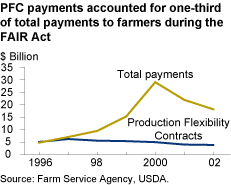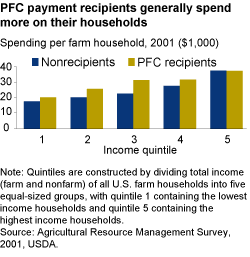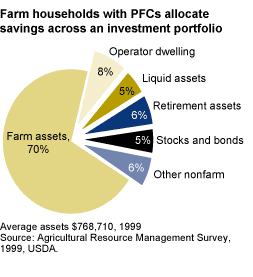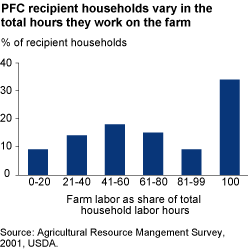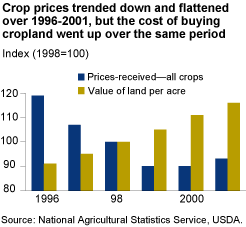Farm Payments: Decoupled Payments Increase Households' Well-Being, Not Production
- by Mary E. Burfisher and Jeffrey W. Hopkins
- 2/3/2003
Nearly all industrial countries provide subsidies to their farmers, often for the purpose of maintaining income from farming or reducing income variability. Traditionally, subsidies in the U.S. and elsewhere have linked payments to current prices and production so as to compensate producers more when market prices for key commodities are low. Such subsidies distort, or alter, the signals sent by market prices alone because, depending on the eligibility rules of specific programs, producers can garner more payments or reduce their revenue risk simply by producing more of the supported commodity.
In the 1996 Federal Agriculture Improvement and Reform (FAIR) Act, the U.S. revamped its farm support and introduced a farm payment that breaks the links between the amounts paid to farmers, their level of production, and market prices. The new support mechanism, called a Production Flexibility Contract (PFC), was a lump-sum cash payment to farm operators based on their historical participation in commodity support programs (see box Implementation of the PFC Program). PFCs have been called decoupled payments because of their implementation rules. They were fixed payments announced in advance for the duration of the FAIR Act (1996-2002). No decision by the farmer nor change in market prices could have altered the size of the lump-sum payment. PFCs transferred nearly $36 billion to eligible producers over the 1996-2002 period, with an average annual payment per recipient household of about $9,000.
When the FAIR Act was adopted, PFCs were expected to be the primary subsidy program for U.S. producers. However, the decline in market prices during the FAIR Act led to the increased use of marketing loan benefits that compensate producers for low prices. Moreover, low world commodity prices resulted in additional, ad hoc emergency government support to agriculture. These payments reduced the role of PFC benefits relative to total commodity program spending; PFCs ultimately accounted for only about one-third of total payments to farmers over the life of the FAIR Act.
Decoupled payments are being continued in the 2002 Farm Security and Rural Investment (FSRI) Act. Now called 'direct payments,' they are expected to amount to about $5 billion annually and will expand beyond the traditional program crops (feed grains, wheat, rice, and cotton) to include historical production of oilseeds and peanuts. Other payments to farmers in the FSRI Act will be from environmental programs and programs that are triggered by low market prices, including countercyclical payments and the marketing loan program.
The Debate Over Decoupled Payments
Decoupled payments have generated considerable international debate regarding the extent to which they distort production. Global trade rules currently do not place any limits on decoupled income support but further constraints on domestic support, which includes decoupled payments, are being discussed in the Doha Development Agenda, the new multilateral round of trade negotiations at the World Trade Organization (WTO).
Economists consider lump-sum subsidies such as PFCs an efficient way to transfer income to targeted recipients. Their main advantage is that they do not distort market price signals such that farmers are encouraged to overproduce, which leads to lower market prices, higher farm program costs, and an inefficient allocation of national resources, often with spillover effects on world markets.
Although PFC payments do not distort price incentives for producers, they can still alter production decisions because payments increase farm operators' income, and the expectation of fixed, future payments increases their wealth. Increased income and wealth from PFCs, as from any other source of income, have lasting effects on households' decisions about how much to spend, save, and work. These household decisions can in turn change the supply of capital and labor in agriculture, and lead to changes in aggregate agricultural production. In order to assess the possible impacts that PFC payments have had on U.S. production, we need to know more about recipient households' spending, saving, and working decisions, and how these may change with increased income and wealth.
Households Receiving PFCs Spend More Than Other Farm Households
Consumption is often overlooked when assessing decoupled payments, but a household's allocation of its payment to consumption reduces the potential for the subsidy to go to its farm operation and perhaps distort production. Furthermore, a change in consumption—such as food/household supplies, rent, mortgage, and insurance—provides a measure of the subsidy's effect on farm household well-being.
For farm households participating in the PFC program, spending on household consumption averaged $26,884 per year in 2001, compared with their average household income of $59,620. (Taxes plus savings account for the remainder, but our data do not allow us to separate the two.) The level of current consumption varies across farm households both by income level (consumption shares of income decline as income increases) and by the life-cycle model typical of other households. For example, older and younger recipient households consume more of their income, while middle-aged households (in their peak earning years) consume a smaller share.
Across most of the income distribution, farm households that received PFCs in 2001 consumed more than farm households with similar incomes not participating in the program. Among the lowest income farm households, recipients' median consumption expenditures (regionally adjusted to reflect cost-of-living differences) exceeded nonrecipients' by about $2,500. Differences tended to be greatest in the middle of the income distribution, and there was no difference in spending at the highest income quintile, perhaps because the payments account for only a small share of their household income.
Expenditure patterns suggest that PFC payments allow recipients to consume more out of income and may allow them to draw down savings that they typically carry as a precaution against income shortfalls. While some expenditures can be curtailed, others must occur to maintain reasonable living standards. The spending gaps between PFC participants and nonparticipants suggest that the payments may help sustain consumption levels during temporary shortfalls in income.
PFC Recipients Are Able To Increase Investments Across the Board
One concern about decoupled payments is that they may enable increased farm investment and lead to higher production levels. Data on the share of PFCs that is saved are not available. However, we do have data on PFC recipients' assets, which show how they allocate their savings among different types of investments.
Survey data from 1999 on PFC recipients' assets—which averaged $768,710 per household—show that they manage diversified investment portfolios. An average of 70 percent is composed of farm assets and the remaining 30 percent is composed of off-farm assets. Farm assets include land, buildings, machinery, and inventories. Nonfarm assets include the operator's dwelling, stocks, bonds, retirement accounts, liquid savings, and other assets. Investment portfolios that are limited to the farm operation are far less prevalent today than in the past.
PFC recipients' diversified portfolios indicate that they exercise considerable choice in their investment decisions and likely seek to equalize expected asset returns, adjusted for risk and taxes. Theoretically, decoupled payments do not change market returns from farm production, and therefore they do not create incentives that encourage onfarm relative to off-farm investments. However, much more needs to be learned about recipient households' savings, and about how they invest an additional dollar of income saved.
PFC payments may indeed lead to additional onfarm investment if they give some farmers the necessary liquidity or collateral to make investments that they could not make without the program. Farmers who cannot purchase inputs (a liquidity constraint), who cannot borrow money at a competitive rate (a credit constraint), or who do not have enough land or equipment (a capital constraint) are likely to increase their farm investments if their incomes and land values are increased through PFC payments. For households operating under such constraints, increasing their incomes and land asset values is likely to increase their farm investment.
Categorizing farms according to high, medium, and low costs of production provides a rough estimate of farms with a high, medium, or low likelihood of facing such constraints because lenders factor costs of production into their lending decisions. Survey data on PFC recipients' costs of production show that dollars invested per acre do not differ based on their cost structure, suggesting that at least in the aggregate, these constraints have not likely determined recipients' farm investment.
It is widely believed that the additional income and wealth of PFC recipients increases the level of risk they assume and the acres they plant. This presumed distortion rests on the belief that farmers are risk averse to begin with. Unfortunately, neither producers' exact risk thresholds nor the empirical relationship between wealth and risk tolerance are well understood. Furthermore, surveys show that PFC recipients use many market mechanisms, such as hedges and forward contracts, to reduce their risk exposure in their farm operation. Households with diversified investment portfolios are also likely to adjust to changes in risk tolerance through reallocations of their whole portfolio. These strategies being used by PFC recipients to manage risk reduce the extent to which changes in risk attitude due to payments, if any, will be evidenced in their production levels or demand for inputs.
Payments Influence Labor and Leisure Choices
Only about a third of all households receiving PFCs devote all of their work hours to their farms, while over 40 percent devote at least four-fifths of their work hours to farm-related labor. For farm households receiving PFC payments, 9 percent work less than a fifth of their work hours on the farm.
Farm household members work less on the farm each year, due to both the 'pull' of nonfarm work and the 'push' from labor-saving technology. Decoupled payments reinforce this trend because increased income and wealth typically allow households to increase their leisure and reduce their work hours. Consistent with this theory, preliminary analysis indicates that PFC payments have led to a slight reduction in households' onfarm work hours, between 1 and 1.5 hours per $1,000 in payments. PFC recipients' labor and leisure choices have not been discussed much in farm program debates; however, they contribute to understanding whether PFC payments may affect production. If the downturn in labor comes from agricultural activities, it could decrease the household's agricultural production (unless labor-saving investments were substituted). For now, the implications of such lifestyle decisions have not been debated by trade partners, especially since the most plausible outcome (less production) would tend to support world commodity prices.
Decoupled Payments Increase Land Values
The main impact of decoupled payments is likely on land values. In well-functioning markets, asset prices reflect expectations about the future returns from their ownership. The PFC program covered a fixed number of base cropland acres, established in 1996 when farmers enrolled in the program, and benefits did not require current production. The direct link between base acres and the known program benefits allowed the future stream of payments to be efficiently capitalized into land values.
Land values set by sales and rental markets can be examined to see whether they track commodity price trends. If these values diverge from prices, it suggests that land markets have additionally capitalized the present and expected future value of government payments. Data show that commodity prices have fallen since 1996 due to a number of factors, while land values have trended upward, consistent with land capitalization of payments. Land rent data, although more fragmented, follow the same trend as land values.
In addition to PFCs, other government payments to farmers that were correlated with current production and commodity prices, as well as development demand for cropland, likely contributed to the increase in land values since 1996. A simulation analysis of the PFC program, which can isolate the role of decoupled payments, showed that the decoupled payments by themselves account for an 8-percent increase in aggregate land asset values.
The Market for Payments: Land Owners Reap Most Benefits
PFC payments are paid to farm operators rather than farmland owners, with payment benefits split between the operator and owners in the case of crop-share rental arrangements. Most of the acreage enrolled in the PFC program is rented. In 1996, the last year for which base acreage tenure data are available, 59 percent of program acres were rented, significantly higher than rental rates for all farmland (42 percent), which includes base acres as well as other cropland, pasture, wetlands, woodlands, and range land.
Land markets for program base acres bring together current owners and potential operators and influence how PFC payments are distributed. If farm operators want to bid on base acreage for rent or purchase, they factor in both the returns from farming and the returns from controlling the right to a PFC payment. In turn, land owners operate, rent out, or fallow land so as to best maximize earnings or complement their lifestyles.
Not all operators can therefore be considered as true beneficiaries of the program, since competitive cropland rental markets work to pass through payments from PFC recipients who are tenants to the owners of base acres. Land rental arrangements can extend over several years or be as short as a single crop year, making rents more likely to reflect short-term expectations about commodity prices and government payments than the market price of land.
The ultimate beneficiaries of PFCs, then, are owners of program base acres. While many owners operate their own land, other owners operate only part of their total acreage (renting out the rest), and still other landowners do not operate their farms at all but rent their acreage to others to farm. Our knowledge about ownership patterns of program acres is incomplete. However, data on ownership of aggregate U.S. cropland show that only 35 percent of rented acres are rented from one active farmer to another, while 65 percent are rented from nonfarming landlords. While these data suggest that a large share of benefits ultimately leave the farm sector, many of these nonfarming landlords have a relationship to farming in that they are retired farmers, widowed spouses, or heirs. Nonfamily corporations or other types of business organization own less than 10 percent of rented farmland.
Some contend that land capitalization reduces the competitiveness of U.S. producers by inflating the cost of land for those who must rent as well as those seeking entry. However, operators' receipt of the payments compensates for higher land costs. Renters and new buyers who receive PFCs are largely no worse off than if the programs didn't exist at all, as long as their subsidy expectations continue to be met.
The often-noted concentration of PFC payments among large farms, then, should be examined more closely to see how tenure patterns may affect the distribution of net benefits. Farm households with sales above $250,000 participating in the program account for 20 percent of recipient farms but received 56 percent of total PFC payments in 2001, suggesting that decoupled payments underwrite the largest, more efficient, operators. However, commercial farms rent 61 percent of the acreage that they operate. Consequently, up to three-fifths of their payment benefits may have ultimately passed through to landowners in the form of higher rent, largely counteracting the effects of payment concentration among large farms.
Intermediate farms also rent a large, but lesser, share of their acreage—52 percent. These farms, with annual sales of under $250,000 and a full-time operator, account for 48 percent of participant farms and 36 percent of all PFC payments. They likely retain more of the payments than do larger farms. Finally, farms with less than $250,000 in sales but with a part-time operator account for 32 percent of participating farms but receive only 8 percent of PFC payments. They rent 46 percent of the acres they operate, and so also likely pass through to landowners some of their program benefits.
Decoupled payments clearly increase the well-being of the operators who receive them, but only when they are owners of base acres. Otherwise, land markets allow a pass-through of payments from operators to landowners, via modified rental arrangements. Despite uncertainty over future policy, land values already reflect the market's expectations about future program benefits.
Conclusion
The experience of the U.S. with decoupled payments has much to offer to the ongoing Doha round negotiations of the WTO. In March 2003, countries will agree on new and perhaps different objectives (known as modalities) for further agricultural policy reform. While still too early to predict which modalities will emerge, the impacts of domestic farm support on international commodity markets will remain a key point of contention among the parties. (See 'Is Japan Ready for Competition in Its Ag Markets?') U.S. decoupled payments seem to demonstrate how to support farmers with minimal distortion of production. Because the payments are lump-sum cash payments to households, they do not directly influence recipients' resource allocation or production levels. Rather, their impacts are evidenced in households' consumption, savings and investment, and labor/leisure choices as their income and wealth increase. For U.S. PFC recipients, these choices today include a range of farm and nonfarm labor and investment prospects. The primary consequence of lump-sum payments has been an improvement in the overall well-being of recipient households that own base acres, where well-being is defined broadly to encompass income, wealth, and consumption, as well as how people choose to spend their time.
This article is drawn from:
- Burfisher, M.E. & Hopkins, J.W. (2003). Decoupled Payments: Household Income Transfers in Contemporary U.S. Agriculture. U.S. Department of Agriculture, Economic Research Service. AER-822.
We’d welcome your feedback!
Would you be willing to answer a few quick questions about your experience?


